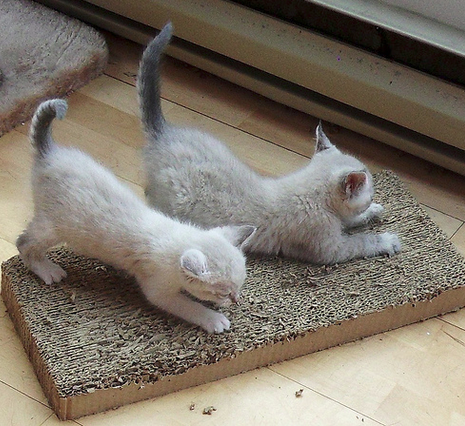Ever wondered what your dog is trying to tell you when he or she barks? Are you confused as to why your cat won’t use its litter tray? As responsible pet owners, we should attempt to learn as much as we can about our pets so that we can easily identify which behaviors are natural and which are a cause for concern.
It is well known that domestic pets are born with a number of natural instincts, from barking to spraying. When these behaviors become frustrating or potentially harmful, it is important that we learn how to deal with them appropriately.
Another behavioral issue with domestic pets is that it’s not always obvious when they are stressed or suffering. Cats are particularly good at hiding signs and symptoms of illness. With the right know-how, however, pet owners can detect when something is wrong with their furry friends.
This post will explain why your cat or dog exhibits certain behaviors and provides advice on how to deal with them.
Dogs
Chewing
Puppies and adult dogs chew things for two main reasons: because they are teething and because they are exploring their environment. Between the third and seventh months of their lives, puppies are teething and chewing on items relieves some of the pain in their gums and promotes the eruption of their adult teeth.
Dogs don’t have sensitive fingers and hands like humans, and so they probe items in their environment using their mouths. Both reasons for chewing are completely natural, and so they should be managed rather than prevented. Removing hazardous items that can be chewed, e.g., power cords and providing safe chew toys will help.
 Barking
Barking
Barking is one of the main ways that dogs communicate with other canines and with humans. Some breeds of dogs are more prone to barking than others. Barking can hold a number of meanings, for example, to warn you of an intruder, to let you know he or she is hungry or wants to play or because the dog is stressed. As you get to know your dog better, you will become more in tune to their barks and what they mean. If ever you notice an obvious change in your dog’s barking habits, it’s always worth seeking advice from a vet.
Excessive barking can be dealt with through careful and patient training. However, do remember that barking is a dog’s natural way of communicating so you can reduce but not remove this behavior completely.
Trucking or scooting
Trucking or scooting is a common behavior exhibited by dogs where they drag their bottoms across the ground. When done once in a while, it’s usually to help your canine satisfy an itch. However, if you notice your dog is doing this on a regular basis, he or she could be suffering from anal sac problems or worms.
Pet wormers can be bought online from stores like Amazon to prevent your dog from getting worms. Fleas are also connected to worm related infections, so it is a good idea to discuss with your vet the various flea control methods available.
Anal sac problems are caused when your dogs anal glands become full and uncomfortable. If left untreated, this can lead to infections. It is possible to deal express the glands manually yourself, but it’s not the most pleasant of jobs so a visit to the vet may be easier. Preventative measures include swapping to a high-fiber dog food.
Cats
Scratching
Scratching is not only a natural feline behavior, it also serves several important purposes for your pet. It helps to keep their claws in good condition and it helps them to stretch properly. Most importantly, it assists them in marking their territory both visually and by scent. Like chewing and barking behavior in dogs, scratching can’t be prevented. Instead, pet owners should take measures to appropriately manage this trait.
Providing your cat with purpose built scratching posts will deter them from digging their claws into your furniture and belongings. Vertical sturdy posts will be the most successful at satisfying your cat’s natural urges to scratch.
Avoiding the litter box
Cats have very high standards when it comes to their litter box. If you don’t keep their litter box clean or position it in an appropriate location; they won’t use it. This can lead nasty surprises to appear around the home which is horrible not just for you, but your cat too.
To ensure your cat has a good relationship with his or her litter box ensure that you scoop the contents at least twice a day and give it a thorough clean every week. Your cat will avoid the litter box if it is positioned too close to its food or water bowl. Place each in a separate room if possible. You can find out additional advice on solving cat litter box problems. If inappropriate toilet behavior continues, you should discuss the issue with your vet.
Spraying
Spraying is another natural behavior in cats to mark their territory. By spraying their urine on various areas, they are warning other cats that they are trespassing on another feline’s domain. Both male and female cats spray, however this behavior is most common in tom cats.
Neutering your cat can prevent your cat from spraying, so contact your vet for advice. Spraying in neutered cats is less common but can still occur if your kitty is stressed. If your cat is spraying persistently due to stress, you may wish to try a Feliway diffuser to help reduce stress and anxiety in your cat. Never punish your cat for spraying as this will only add to their stress levels.
As pet owners know well, cats and dogs are complex creatures. As well as the common behaviors discussed above, there are a lot more habitual traits that these animals possess. To ensure you understand your pet as best you can and provide them with excellent care, it is important to continue learning about the intricacies of your cuddly companions.



Speak Your Mind